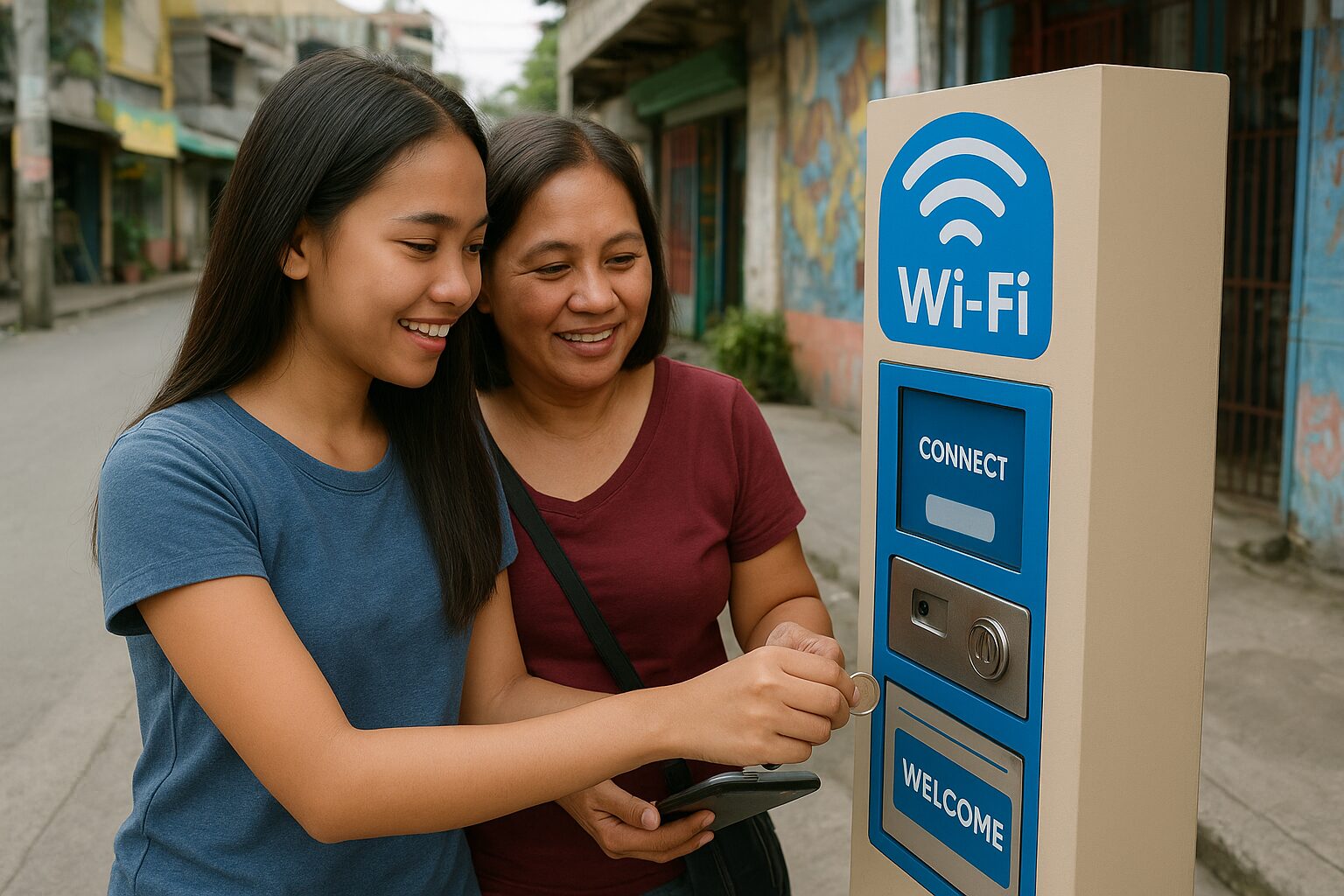In many parts of the Philippines, internet access remains a challenge. Whether you’re in a rural community or a busy city, having an affordable and reliable connection is essential. This is where Piso WiFi comes in—a local innovation that allows anyone to get online for as low as one peso.
Piso WiFi has become a game changer for students, workers, and small business owners. It offers budget-friendly internet access without the need for expensive monthly subscriptions. In this guide, we’ll help you understand what Piso WiFi is, how it works, its benefits and challenges, and how you can even start your own Piso WiFi business.
What Is Piso WiFi?
Definition and Basic Concept
Piso WiFi refers to a coin-operated WiFi hotspot system that allows users to connect to the internet by paying a small amount—usually one peso—for a few minutes of usage. The term “Piso” literally means “one peso” in Filipino, which explains the name.
It’s commonly installed in public areas such as sari-sari stores, internet cafés, waiting sheds, schools, and small businesses. Users simply connect their devices to the WiFi network, pay using coins or e-wallets, and enjoy timed internet access.
How Piso WiFi Got Its Name
The concept started as a low-cost alternative for those who couldn’t afford fixed broadband subscriptions. By inserting a coin worth one peso, users could surf the web for a limited time—usually 5 to 10 minutes—depending on the owner’s settings.
Short History or Origin of Piso WiFi Systems
Piso WiFi began as a grassroots innovation in the Philippines. Over time, companies like PisoNet, Vendo WiFi, and LPB Piso WiFi popularized it by offering affordable vending machines and routers. With the rise of mobile internet and the need for flexible access, Piso WiFi systems quickly became a nationwide trend.
How Piso WiFi Works
A Piso WiFi setup is surprisingly simple. Here’s how it typically works:
Components of a Piso WiFi Setup
- Piso WiFi Machine – A vending device where users insert coins or load credits.
- Router – Distributes the internet signal to connected devices.
- Portal System (Admin Dashboard) – Allows the operator to manage users, set rates, and monitor usage.
- Internet Source – Usually from a DSL, fiber, or LTE connection.
Step-by-Step Process
- Connect your phone or laptop to the Piso WiFi network.
- Open your browser; the login portal automatically appears.
- Insert coins or use digital payment options like GCash or Maya.
- Once the payment is confirmed, the system activates your connection for the specified time.
For example, ₱1 might give you 5 minutes of internet, while ₱5 could give you 30 minutes, depending on the setup.
Common Piso WiFi Features
Piso WiFi machines today are more advanced than ever. Some common features include:
- Time-Based Internet Access – Users pay for a set time (e.g., 5, 15, 30 minutes).
- User Management – Admins can monitor connected devices and control bandwidth.
- Bandwidth Control – Prevents users from consuming too much data at once.
- Advertisement Display – Some systems show ads while users connect, generating extra income.
- Remote Access – Business owners can manage their Piso WiFi units online using mobile apps or web dashboards.
Visual: Piso WiFi Usage Statistics (Philippines 2024)
| Region | % of Barangays with Piso WiFi Access | Growth Since 2020 |
|---|---|---|
| NCR | 78% | +35% |
| Central Luzon | 64% | +41% |
| Bicol Region | 59% | +38% |
| Mindanao | 54% | +33% |
| Visayas | 61% | +29% |
This growth shows how Piso WiFi is helping bridge the digital divide across the country, especially in areas with limited broadband options.
Benefits of Piso WiFi
1. Affordable Internet for Everyone
The main advantage of Piso WiFi is its affordability. Anyone can access the internet with just a few coins or via e-wallets.
2. Easy Setup for Entrepreneurs
Starting a Piso WiFi business doesn’t require a big investment. Machines are now plug-and-play and can be managed through apps.
3. Pay-As-You-Go Flexibility
Users love that they only pay for what they need—no contracts, no monthly bills.
4. Rural Accessibility
Piso WiFi provides internet access in far-flung areas, giving students and workers new opportunities for online learning and remote work.
Challenges and Limitations
While Piso WiFi is helpful, it’s not perfect. Here are some common challenges:
1. Slow Connection Speeds
Since multiple users share the same network, speed often drops during peak hours.
2. Maintenance and Technical Issues
Machines need regular cleaning and occasional software updates.
3. Security and Privacy Risks
Public WiFi can expose users to data theft if the system isn’t secured properly. Avoid entering sensitive information like bank details when connected.
4. Dependence on Stable Internet Providers
A Piso WiFi’s performance still depends on its main internet source—if the ISP is down, so is the WiFi service.
Piso WiFi Business Setup
Thinking of starting your own Piso WiFi business? Here’s what you need to know.
How to Start
- Purchase a reliable Piso WiFi vending machine.
- Subscribe to a fiber or LTE internet plan.
- Set up your router and machine in a high-traffic area (like stores or terminals).
- Configure your rates, time limits, and WiFi name through the admin portal.
Equipment and Cost
| Item | Estimated Cost (PHP) |
| Piso WiFi Machine | ₱5,000 – ₱10,000 |
| Router | ₱1,000 – ₱3,000 |
| Internet Plan | ₱1,500 – ₱2,500/month |
| Miscellaneous (extension cords, signage) | ₱500 – ₱1,000 |
Total Initial Setup: ₱7,000 – ₱15,000
Tips for Success
- Place your machine in areas with high foot traffic.
- Offer flexible rates (₱1 for 5 mins, ₱5 for 30 mins, ₱10 for 1 hour).
- Promote your hotspot using social media or local signage.
- Regularly check your router and update firmware for smooth operations.
Tips for Piso WiFi Users
- Check Signal Strength: Move closer to the machine for better connectivity.
- Use Data Saver Mode: This extends your paid time.
- Avoid Heavy Streaming: Watching HD videos can consume your time faster.
- Secure Your Device: Avoid entering passwords or personal data on public WiFi.
- Disconnect When Idle: Save your remaining minutes for later use.
The Future of Piso WiFi in the Philippines
The demand for affordable internet continues to grow. Piso WiFi is expected to evolve in the following ways:
1. Integration with Mobile Apps
New systems now allow users to connect and pay through GCash or QR codes, removing the need for coins.
2. Smart Data Management
Future Piso WiFi systems may include AI-powered traffic control, ensuring fair bandwidth distribution.
3. Community Connectivity Projects
Local governments and private companies are exploring Piso WiFi-style setups to provide free or subsidized WiFi in schools and barangays.
4. Nationwide Expansion
With better fiber infrastructure, Piso WiFi could soon become a standard service even in the most remote provinces.
Conclusion
Piso WiFi has become an essential part of Filipino life—offering accessible, flexible, and affordable internet to millions. It’s not just a business opportunity; it’s a bridge that connects communities to education, work, and communication.
While challenges remain, the potential of Piso WiFi continues to grow, shaping the country’s path toward universal digital inclusion.
Frequently Asked Questions (FAQs)
1. What does Piso WiFi mean?
Piso WiFi means “one-peso WiFi,” referring to an internet service you can access by paying a small amount.
2. How much does it cost to use Piso WiFi?
Usually ₱1 for 5–10 minutes, depending on the owner’s settings.
3. Can I use Piso WiFi on my phone?
Yes. You just connect to the hotspot and log in using the browser portal.
4. Is Piso WiFi secure?
While convenient, Piso WiFi is a public network, so avoid accessing sensitive accounts.
5. How can I start a Piso WiFi business?
You’ll need a Piso WiFi machine, router, and internet connection. It’s affordable and easy to set up.
6. How do I extend my connection time?
Insert more coins or pay digitally to add more minutes.
7. Can I control my Piso WiFi remotely?
Yes, modern Piso WiFi systems allow remote access via admin portals or mobile apps.
8. What are the best locations for Piso WiFi machines?
High-traffic areas like sari-sari stores, terminals, or boarding houses.
9. Can Piso WiFi work without coins?
Yes, some systems accept GCash, PayMaya, or QR payments.
10. Why is Piso WiFi important in the Philippines?
It provides affordable internet access to areas with limited connectivity, promoting digital inclusion.
Disclaimer
This article is for informational and educational purposes only. The data, costs, and features mentioned are based on publicly available information and may vary by provider or location. Always research and verify before making any business or technical decisions.



